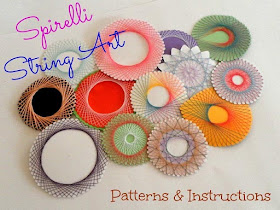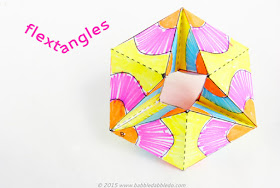A couple weeks ago, I posted about
creating string art with my kids. While we were making these masterpieces, I kept thinking that it might be an easier project to accomplish if you had some templates! Especially if you are working with younger kids. So I whipped up a couple and gave it a try...
Download templates here.
The first version I attempted used a hole punch. This works well, but creates some rather big holes in your design.
But if you're working with younger children, this should make it easier to thread a plastic needle through the holes. Here are some instructions, if you'd like to give this a try:
Supplies:
Craft Foam Sheets - 8 1/2" X 5 1/2" or larger
Hole Punch (or paper punch/poker thingy)
Scissors
Plastic sewing needles
Variety of yarns
1) Print out the template. The first one in the file (
template #1) makes the design above and is the easiest to sew.
2) Cut your foam sheet to 5 1/2" X 5 1/2" and cut closely around the template. Tape the template on top of the foam at the edges.
3) Use your hole punch to punch out all the black dots. It's a little bit harder to punch through foam than paper, but it works fine.
4) I wanted to leave the number guides on the foam for ease of sewing, so I cut around the inside of the holes and removed the inner section of paper. If you have the template taped securely along the edges of the foam, the numbers should stay in place.
Now I am ready to sew!
5) I started with about 8ft of yarn. Thread that onto your needle.
6) Tape one end of the yarn to the back of the project.
7) Bring your string up through hole number one and then down in hole number two. Come back up through hole number three and continue.
8) For this template, I decided to change colors after hole number 18, so I cut the string and taped the end to the back.
9) Thread a new color onto your needle and begin again at hole number 19. (You'll notice that this is also hole number 1). Proceed to hole number 20 and finish at number 36.
10) When you're done, remove the paper template and your masterpiece is ready!
For the second version of this project, I used a paper poker tool to create the holes for the needle. (I really can't remember what these are called, but above is a picture of one.) I'm pretty sure you can get these at a scrapbook supply store. Maybe they even make hole punchers with smaller holes! Anyhow, the point (pun intended) of using this tool is to get smaller holes.
For this project, I used
template #2. You can see the tiny holes created by the tool above. The big plastic needles slide through these small holes just fine.
This is what template #2 looks like when finished. To get this effect, use two colors. With the first colors sew from holes 1 to 36. Then switch to a different color and sew from holes 37 to 72.
If you want to use 4 colors (one for each corner), then switch colors like this:
Color 1 - sew from 1 to 18
Color 2 - sew from 19 to 36
Color 3 - sew from 37 to 54
Color 4 - sew from 55 to 72
To create this project, use
template #3. With one color, sew from 1 to 56.
You can vary this design by adding another layer of color. Simply start at hole 1 and then decide how many holes you want to skip before you sew. For the yellow, I brought my thread up through a hole, skipped four holes, and brought my thread down through the fifth. You can vary how big your final circle will be by changing how many holes you skip!
Template #4 is more complex. You can use the template to create a rainbow flower.
I used the template to create this spiral instead. To create this, simply sew every other letter. So I sewed from A1 to A18, then C1 to C18, E1 to E18, G1 to G18, I1 to I18, and K1 to K18 all with a single color.
To get the look of the flower, sew from A to K, switching out your colors for every letter.
The easiest template for young kids will be
temple #1. They will need to be able to count from 1 to 36 and not get too frustrated when their yarn becomes tangled. Moms are great at helping with untangling!
Template #3 is also not too difficult.
I also found this easy tutorial,
Spirelli String Art, for creating circular string art. It uses cut paper circles with notches, and the thread is wrapped around the circle. Sounds quite simple. And those are some pretty circles they have made!
Good luck with your string art projects and let me know below if you have any questions!
















































